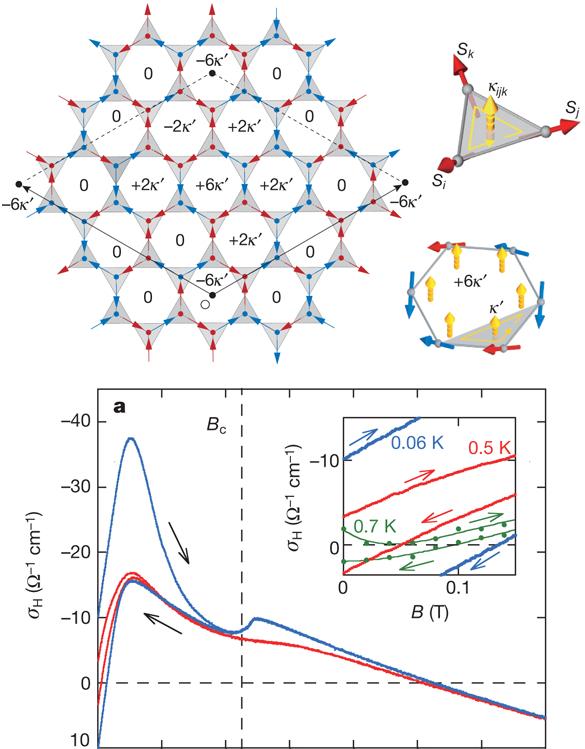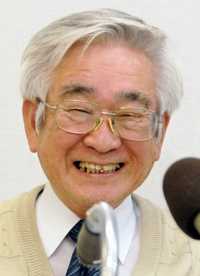In a bulk semiconductor the translation invariance imposes strict selection rules for the optical transitions. The wavevector conservation is required. Thus, an electronic excitation with wavevector K is coupled with a single mode of the electromagnetic field with the same wavevector. This leads intrisically to a strong coupling regime and the system eigenstates are mixed ligth-matter states, the polaritons. Polaritons dispersion curves can be calculated (figure below rigth part) or measured by means of two-photon absorption or Hyper-Raman scattering techniques (figure below on the left).

Polariton dispersion in a bulk semiconductor (calculated rigthside and measured leftside)
For small wavevector the lower energy polariton shows a quasi-photonic dispersion and a quasi-excitonic one for large wavevectors. The situation is reversed for the upper polariton. However the observation of these coherent states is not straigthforward. Indeed, their coherence has to be preserved in both space and time domains. Strictly speaking a bulk semiconductor cannot produce a photoluminescence signal, the radiative recombination occurring only at the material surface. However a lot of decoherence sources exist in a real material and polaritons have a finite lifetime. Thus, excitonic recombination can be observed only dure to the presence of defects unavoidable in a solid medium. In a bulk semiconductor the excitonic recombination is somehow an extrinsic phenemenon. The picture is quite different in a semiconductor quantum well. The translation invariance is broken along the heterostructure growth axis Oz. The polaritons, which still exist in the plane perpendicular to the growth axis, are coupled to a continuum de electromagnetic modes along Oz. They are in a weak coupling regime, thus instable and give rise to a photoluminescence signal. In a quantum well the photoluminescence signal due to excitonic recombination is intrinsic and the presence of defects only modifies its properties.The life time of an exciton in a quantum well is given by
of an exciton in a quantum well is given by  with
with  the semiconductor refraction index, the electron mass, and
the semiconductor refraction index, the electron mass, and  the excitonic oscillator stength per unit area.
the excitonic oscillator stength per unit area.
When a quantum well is inserted in a microcavity the situation is deeply modified. In a microcavity a semiconductor layer with a thickness comparable to the ligth wavelength is placed between two Bragg reflectors. Such a mirror is schematized below and constituted by a stack of N pairs of semiconductor layers with different optical indices
semiconductor layers with different optical indices  et
et  .
.

Scheme of a Bragg reflector and corresponding reflectivity.
Its reflectivity reads:
reads:  and is depicted in the above figure
and is depicted in the above figure  and
and  are the refraction indices of the media located on the rigth and left sides of the mirror. The reflection band of the mirror ("stop-band") is given by :
are the refraction indices of the media located on the rigth and left sides of the mirror. The reflection band of the mirror ("stop-band") is given by :  with
with  the average index of the structure. When a low thickness semiconductor layer is inserted between two such mirrors one obtains a microcavity with only one electromagnetic mode in its stop-band as shown in the figure below.
the average index of the structure. When a low thickness semiconductor layer is inserted between two such mirrors one obtains a microcavity with only one electromagnetic mode in its stop-band as shown in the figure below.

Scheme of a microcavity and corresponding reflectivity spectrum.
The quantum well embedded in the cavity will be coupled with a single mode of the electromagnetic field in the direction Oz. One recovers a situation of strong ligth-matter coupling. This latter situation can be described phenomenologically by considering two interacting oscillators, the exciton with energy and spectral width
and spectral width  and the cavity with energy
and the cavity with energy  and width
and width  . One obtains the system eigenenergies
. One obtains the system eigenenergies  after diagonalization of the matrix :
after diagonalization of the matrix :  with
with  , the coupling element, where
, the coupling element, where  and
and  are the cavity length and index. The eigenenergies read :
are the cavity length and index. The eigenenergies read : . At resonance
. At resonance  equals
equals  and the energy splitting between the eigenstates (often named "Rabi splitting")
and the energy splitting between the eigenstates (often named "Rabi splitting")  is given by
is given by  . This splitting is maximum for same exciton and cavity spectral widths. Nevertheless, the strong coupling regime is only reached for sufficient excitonic oscillator strengths when the Rabi splitting is larger than these latter spectral widths.
. This splitting is maximum for same exciton and cavity spectral widths. Nevertheless, the strong coupling regime is only reached for sufficient excitonic oscillator strengths when the Rabi splitting is larger than these latter spectral widths.
Experimentally the strong coupling can be observed in the reflection spectrum of the microcavity. The cavity layer is always grown with a thickness gradient. This allows to vary the length of the cavity by shifting the laser spot along the sample surface. When the exciton and cavity modes enter in resonance the reflection peak in the reflection spectrum splits. This splitting is characteristic from the appearance of the microcavity polaritons. The anticrossing curve of the two modes can be deduced from the reflection spectra as shown in the figure below.

Strong coupling in a semiconductor microcavity. Reflectivity spectra and anticrossing of the exciton and cavity modes (after C. Weibuch et al, PRL 69 (1992).
Edymar Gonzalez A
Polariton dispersion in a bulk semiconductor (calculated rigthside and measured leftside)
For small wavevector the lower energy polariton shows a quasi-photonic dispersion and a quasi-excitonic one for large wavevectors. The situation is reversed for the upper polariton. However the observation of these coherent states is not straigthforward. Indeed, their coherence has to be preserved in both space and time domains. Strictly speaking a bulk semiconductor cannot produce a photoluminescence signal, the radiative recombination occurring only at the material surface. However a lot of decoherence sources exist in a real material and polaritons have a finite lifetime. Thus, excitonic recombination can be observed only dure to the presence of defects unavoidable in a solid medium. In a bulk semiconductor the excitonic recombination is somehow an extrinsic phenemenon. The picture is quite different in a semiconductor quantum well. The translation invariance is broken along the heterostructure growth axis Oz. The polaritons, which still exist in the plane perpendicular to the growth axis, are coupled to a continuum de electromagnetic modes along Oz. They are in a weak coupling regime, thus instable and give rise to a photoluminescence signal. In a quantum well the photoluminescence signal due to excitonic recombination is intrinsic and the presence of defects only modifies its properties.The life time
 with
with When a quantum well is inserted in a microcavity the situation is deeply modified. In a microcavity a semiconductor layer with a thickness comparable to the ligth wavelength is placed between two Bragg reflectors. Such a mirror is schematized below and constituted by a stack of N pairs of

Scheme of a Bragg reflector and corresponding reflectivity.
Its reflectivity
 with
with 
Scheme of a microcavity and corresponding reflectivity spectrum.
The quantum well embedded in the cavity will be coupled with a single mode of the electromagnetic field in the direction Oz. One recovers a situation of strong ligth-matter coupling. This latter situation can be described phenomenologically by considering two interacting oscillators, the exciton with energy
 with
with  , the coupling element, where
, the coupling element, where  . At resonance
. At resonance  . This splitting is maximum for same exciton and cavity spectral widths. Nevertheless, the strong coupling regime is only reached for sufficient excitonic oscillator strengths when the Rabi splitting is larger than these latter spectral widths.
. This splitting is maximum for same exciton and cavity spectral widths. Nevertheless, the strong coupling regime is only reached for sufficient excitonic oscillator strengths when the Rabi splitting is larger than these latter spectral widths.Experimentally the strong coupling can be observed in the reflection spectrum of the microcavity. The cavity layer is always grown with a thickness gradient. This allows to vary the length of the cavity by shifting the laser spot along the sample surface. When the exciton and cavity modes enter in resonance the reflection peak in the reflection spectrum splits. This splitting is characteristic from the appearance of the microcavity polaritons. The anticrossing curve of the two modes can be deduced from the reflection spectra as shown in the figure below.

Strong coupling in a semiconductor microcavity. Reflectivity spectra and anticrossing of the exciton and cavity modes (after C. Weibuch et al, PRL 69 (1992).
19.502.773
CRF
http://www.lpa.ens.fr/spip/spip.php?article85&lang=en








 partículas sin masa (bosones de Nambu-Goldstone).
partículas sin masa (bosones de Nambu-Goldstone).

